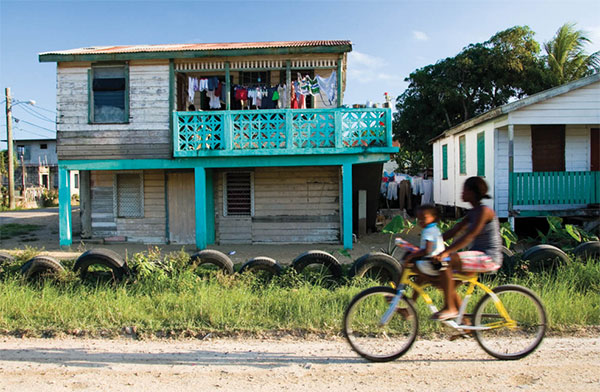SETTLEMENT DAY
A carnival atmosphere consumes Dangriga during the celebration of Garífuna Settlement Day on November 19, which commemorates the landing of Garífuna leader Elijio Beni and his followers at the mouth of the North Stann Creek River. The town swells with Garífuna from all over Central America and the United States. Singing and dancing crowds, all in traditional Garífuna costume, follow drummers from house to house until sunrise, when everyone gathers at the riverside for a re-enactment of the Landing. This is followed by a procession to the Sacred Heart Roman Catholic Church, to attend the special Mass performed entirely in Garífuna to the rhythmic beat of the drums. Many restaurants and bars, particularly in Dangriga and Hopkins, also offer special meals and drinks in honor of Garífuna Settlement Day.
Dangriga and the Stann Creek District
Stann Creek District is the home of Garífuna culture, famous for its arts, dance, and punta rock music. You’ll also find some superb caves inland and idyllic cayes out on the reef.
The Hummingbird Highway, running from Belmopan to Dangriga, has a beautiful name, amply justified by the surrounding scenery, which is among the most spectacular and tropical of southern Belize. The road passes through a magnificent forest of cohune palm: Cohune Ridge, as it is known locally. The largest town in Stann Creek District, Dangriga ° [map] , which takes its name from the local Garífuna language, loosely meaning ‘standing waters.’ It lies peacefully along the banks of the North Stann Creek River, whose water is legendary: the town’s drinking supply is refreshingly cool and arguably the best-tasting water in Belize. A well-known Belizean saying warns that once you drink from gumaragaru (the Garífuna name for the North Stann Creek River), you must come back to Dangriga.

Traditional stilt houses, Dangriga.
Corrie Wingate/Apa Publications
Tip
Tables across the country have one thing in common: bottles of trademark Marie Sharp’s hot pepper sauce. This is Belize’s most beloved hot sauce, and near Dangriga, you can go to its source. Twelve kilometers (8 miles) northwest of Dangriga, near Melinda Forest Station, is the Marie Sharp’s Factory (www.mariesharps.bz; Mon–Fri 7am–4pm) set on a 162-hectare (400-acre) estate. Guided tours take in the fields, orchards, and factory, and you can pick up a bottle (or five) to take home.
Dangriga was settled in the early 19th century by the Garífuna, or Garínagu, formally known as Black Caribs, a cultural hybrid of African and Indigenous Caribbean people. The town’s dreamy atmosphere still harks back to a past age. The houses are made of weathered wooden planks and raised on stilts. Old-fashioned wooden fishing dories are tied up along the banks of the river, beside canopied ferries with hustling fishermen unloading their day’s catch.
At heart, Dangriga is a celebration of Garífuna culture, marked by one important landmark − the Drums of Our Fathers monument, in the southern part of town, that pays homage to the key role of drumming in Garífuna history. Dangriga is bisected by North Stann Creek, crossed by a bridge; on the north side are the town hall and small market, on the south the post office. For an excellent overview of Garífuna culture, head to the Gulusi Garífuna Museum (Mon–Fri 10am–5pm, Sat noon–8pm), on Stann Creek Valley Road, which features in-depth exhibits tracing Garífuna history, as well as artworks, traditional dress, and more. There are budget hotels, lively restaurants, and raunchy bars in the center of town if you fancy a night out. Just north of town is the Pelican Beach Resort (www.pelicanbeachbelize.com), which maximizes its beachfront perch with breezy rooms and a restaurant with views out to sea.
GARIFUNA ARTS AND CRAFTS
The Garífuna have a long legacy as artists and craftsmen. Primitivism dominates in their painting, with great elaboration of detail, flat colors, and unreal perspective. Dangriga local Pen Cayetano, an acclaimed punta rock musician, is also an accomplished artist, having displayed at many art exhibitions in the United States and Europe. Pen’s work is more realistic than other Garífuna painters, but it still retains the attractive aspects of primitivism. To view Cayetano’s collection, pay a visit to the Pen Cayetano Studio Gallery (www.cayetano.de; Mon-Fri 9am-5pm), near Ecumenical Drive, which also features historical exhibits on Garífuna culture, drumming demonstrations, and more.
Throughout town, you’ll also find a colorful array of other crafts, including drums made with cedar and mahogany and deer and cow hides; stuffed cotton dolls in traditional Garífuna dress; coconut-leaf baskets and hats; and maracas made of dried calabash gourds. In the past, the National Garífuna Council of Belize has run arts and crafts workshops to encourage the preservation of such skills, ensuring Garífuna traditions are passed down through the generations. Ask at any of the local restaurants, and they’ll point you in the direction of craftspeople who are selling their wares.